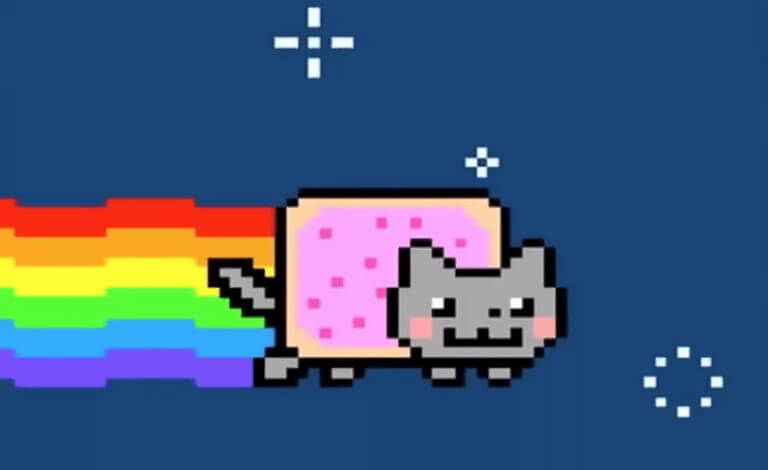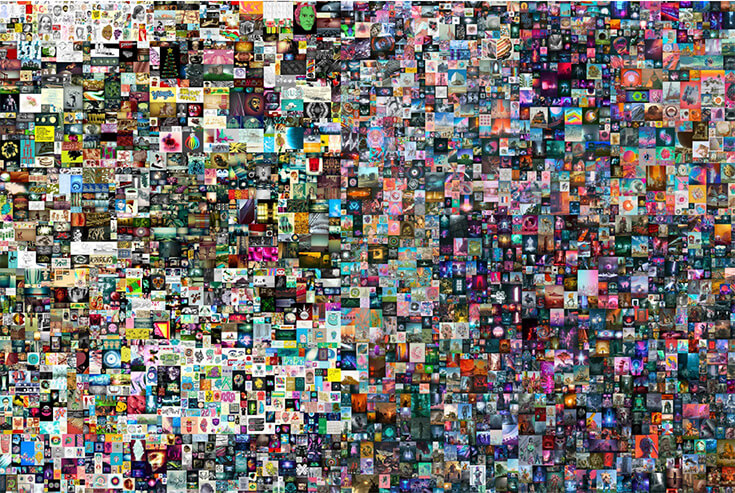You may have heard a thing or two about NFTs lately. That tends to happen when a relatively unknown artist sells an NFT jpeg file for $69 million at auction.
Also known as non-fungible tokens, NFTs have, however, been around for a lot longer than the last couple months: Since 2014, to be exact. That’s when the Ethereum blockchain published its ERC-721 non-fungible token standard, enabling the existence of NFTs on the blockchain network (NFTs can technically exist on any blockchain network, but the ones you’ve heard about recently are on Ethereum).

The Nyan Cat NFT sold for hundreds of thousands of dollars on the crypto art platform, Foundation, earlier this year. Image: Nyan Cat
What is an NFT?
NFTs are unique tokens that have value precisely because of that uniqueness, a little bit like digital trading cards (and we all know how valuable vintage trading cards can get). Because they live on a blockchain, ownership of every NFT is a public record and can be verified (along with a history of every transaction involving that particular NFT).
An NFT can be anything digital – a jpeg, a video clip, or a piece of music. Heck, even news columns and tweets have been auctioned as NFTs.
But the current craze is mostly driven by digital artwork, at least so far. One of the original NFT ideas were CryptoKitties in 2017 (“collect and breed digital cats!”). CryptoPunks (2018) was another one. Decentraland (2018) is a blockchain-based virtual world where users can buy and sell NFT digital assets. And the video game NBA Top Shot has reportedly earned around $50 million by selling game-themed NFT collectibles.
NFT creators can make available as many or as few NFTs as they like – some NFTs are truly one of a kind, while others are more like a limited edition. The next Kings of Leon album, for example, was available to purchase as an NFT for two weeks and is now a limited edition, tradable collectible. Other musicians, such as Portugal. The Man, Shawn Mendes, and Mike Shinoda of Linkin Park have also gotten into NFTs as the Covid-19 pandemic decimated the live music industry over the past year or so.
Need to Send or Receive Large Files?
Does that mean NFTs can’t be copied?
Not exactly. Anyone can copy an NFT and download it to their computer, as with any other digital file. Similar to fine art collecting, however, the real value is in the owning of the original. Think of it this way: Anyone can buy a Dali print at a sidewalk poster sale, but only one can own the original. There’s inherent value in that, especially among collectors.
Some in the NFT world have already figured out ways to add more value than what some have called “symbolic ownership”. Video game developers and publishers are tinkering with ways to release in-game items (such as unique outfits, weapons, and other gear) as NFTs, which have real in-game value for gamers.
It’s also worth noting that NFTs typically don’t confer any real-world ownership, such as copyright, but they can if the seller wishes.

“Everydays: The First 5000 Days”, a collage by Beeple, sold for $69M at Christie’s. Image: Beeple
So how can I buy an NFT? Do I have to spend big bucks at a Christie’s auction?
Not at all! There are several online NFT marketplaces, such as Nifty Gateway, OpenSea, and Crypto.com. Peruse the listings for just a few minutes and you’ll see a range of NFT products up for auction, with wildly differing price points – this collection of “Snoop Dogge Coins” (2,579 editions) sits at just $112 as of this writing, while this three-minute video clip from Aston Martin (61 editions) has a starting price of $8,000.
Once purchased, NFTs typically live in digital wallets that support NFTs such as AlphaWallet or Trust Wallet.
And as we’ve seen in the news, other, more in-demand items have gone for far more than the examples I just mentioned. Owning an NFT is essentially like owning any other speculative asset, after all. As with any other auction of any other item, the price is determined largely by a combination of supply and demand (and maybe a little bit of hype for good measure).
I think I’m starting to see how filmmakers could make use of this.
Glad to hear it. But don’t just take my word for it. L.A.-based filmmaker and blogger Noam Kroll says NFTs will become “the next great revenue stream for filmmakers” – and honestly, it’s not hard to see how. As we’ve seen, one-of-a-kind and even limited edition NFTs can sell for orders of magnitude more than many of us thought possible even a few months ago. Just like digital artists selling NFT jpegs, filmmakers can do the same with their work.
“Now imagine this,” he writes. “You are a fairly well established filmmaker. You decide to make a 2 minute short film and sell a limited run of 100 authentic digital copies via NFT. Each copy of the film is sold for $1,000. Upon release, you immediately sell all 100 copies of the film for $1,000. You’ve already profited $100,000 from your two minute short film.”
While reaching mass audiences will likely still be within the purview of traditional distribution, at least for now, filmmakers can use NFTs to sell authentic digital copies of their work that could generate far more revenue than traditional methods – and far more quickly.
Need to Send or Receive Large Files?
Does that mean I’ll get rich as soon as I produce an NFT?
You… could. But there’s a catch – as when monetizing any other piece of art, for there to be any interest in your NFT, you need a following. You need fans. “Remember,” writes Kroll, “what they are paying for isn’t just the film. It’s an investment in an asset that they believe will appreciate over time. They are really investing in you, not paying to watch your movie.”
The more success you have in the future, the more their NFT will be worth. The more of a fan base you have, the more success you’ll have selling your NFTs now. Simple, right?
Further, the more demand for your NFT, the more you could profit from royalties off each sale (creators of NFTs can set a royalty percentage they automatically receive from each future sale).
But if you’re looking to mint your own NFT and aren’t sure what price to set, you’re not alone. “It’s very difficult to come up with any kind of a metric for what is reasonable when people are paying $69 million for a jpeg and $590,000 for a gif of a flying Pop-Tart cat with rainbows coming out of its butt,” says filmmaker Adam Benzine in this blog post from the British Film Institute (BFI).
Who else in film is experimenting with NFTs? Will I be an early adopter?
The film world is a little behind some other mediums, such as music and visual art, when it comes to NFTs – but is coming on strong lately. “This is a revolution. I think we’re in a period of time that will be looked back on as probably greater than the Renaissance,” says film producer and NFT artist Julie Lindsay in the same BFI blog post.
“I’ve never seen so many artists quitting their jobs, doing nothing but creating full time.”
Indeed, NFTs are catching on in the film world. Kevin Smith’s next film is being auctioned as an NFT. Benzine recently auctioned ten NFTs based on his Oscar-nominated documentary feature Claude Lanzmann: Spectres of the Shoah.
And The Forest Road Company recently set up a $20M NFT fund to help indie producers monetize their content. The fund will invest in films in exchange for the right to sell NFT collectibles based on those films, with producers getting a cut of the royalties once Forest Road earns back its investment.
So does all this mean NFTs can be my next controversy-free new revenue stream?
Not exactly. NFTs do have some baggage, most significantly on the climate change front. That’s because NFTs live on blockchains, and many blockchains require an eff-ton of electricity to produce and maintain — Ethereum being one of them. They’ve even been called “environmentally unethical” by some observers.
That being said, some artists, like Beeple (who sold the $69M jpeg file), have said they’ll re-invest some of their profits into environmental initiatives to try to offset the damage. Moreover, many blockchains are moving away from energy-intensive computation to more environmentally friendly models to sustain their network and security. For example, Ethereum has rolled out a plan to adopt a sustainable model through proof-of-stake.
So there you go! Your quick rundown on how NFTs could be your next revenue stream as a filmmaker. Just do us one favor: When you end up selling your next video clip as an NFT for millions of dollars, don’t forget us little people.
If you enjoyed this post, you might also enjoy learning about how video professionals are saving time and money using MASV to send large files.
Need to Send Large Files?
Create a free MASV account to get started